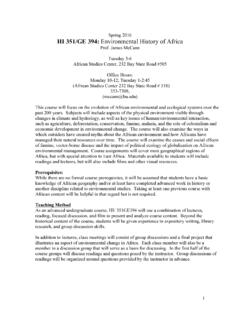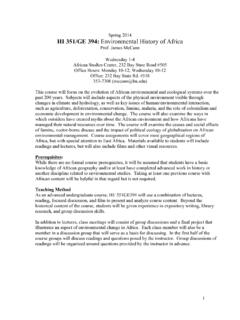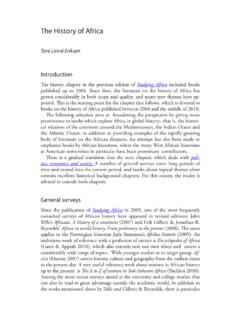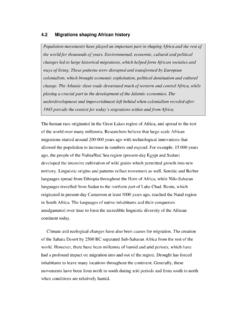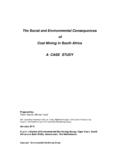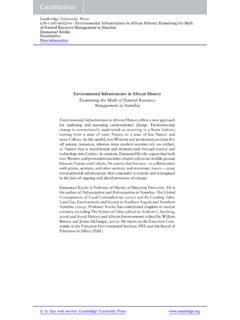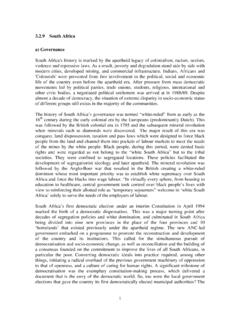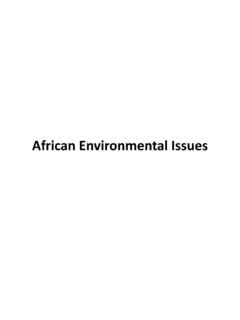Transcription of A REVIEW OF THE EVOLUTION OF …
1 ELSEVIER environmental POLICY MAKING A REVIEW OF THE EVOLUTION OF environmental evaluation procedures IN south africa Merle Sowman, Richard Fuggle, and Guy Preston University of Cape Town, Rondebosch, south africa In 1989, the Council for the Environment, an advisory committee to the Minister of Environment Affairs, published a document outlining an environmental evaluation procedure appropriate to south Aji-ica s circumstances. This procedure, termed integrated environmental management (IEM), is designed to ensure that the environmental impacts and implications of proposals (including policies, programs, plans, and projects) are investigated and adequately considered in the planning and decision-making process. This article provides an historical perspective on the events that contributed to the development of IEM,as well as some insights into the socioeconomic and political factors that injluenced the form of evaluation eventually recommended for south Aj?
2 Ica. A description and appraisal of the IEM procedure is then presented. Introduction The enactment of the National environmental Policy pict of 1970 (NEPA) in the United States is recognized worldwide as the formal inception of environmental impact assessment (EIA)-a procedure for identifying and investigating the environmental consequences of development, as an aid to decision-making. This event triggered the development and implementation of formal and informal environmental evaluation * procedures in both developed and developing Address requests for reprints to: Merle Sowman, environmental evaluation Unit, University of Cape Town, Private Bag, Rondebosch. 7700, south africa . The broad term environmental evaluation is used because it encompasses the more specific activities of environmental (impact) assessment, environmental analysis, and initial environmental assessment.
3 ENVIRON IMPACT ASSESS REV 1995;15:45-67 0 1995 Elsevier Science Inc. 655 Avenue of the Americas, New York, NY 10010 0195-9255/95/$ SSDI 0195-9255(94)00004-K 46 MERLE SOWMAN, RICHARD FUGGLE, AND GUY PRESTON countries. Whereas the adoption of environmental evaluation procedures , either by legislative or administrative control, has been in evidence in many developing countries since the late 1970s (Horberry 1984; Wathem 1988; Brown 1990; Sorensen and West 1990), south africa has been slow to develop procedures appropriate to its circumstances. It was only as recently as 1989, that south africa enacted legislation (Act 73) which provides for the determination of environmental policy to guide decision-making. Provisions exist in the new environmental Conservation Act 73 of 1989 to regulate activities that may have a detrimental impact on the environment and to require that environmental impact reports be prepared.
4 In that same year, a document was published (Council for the Environment 1989) outlining a recommended evaluation procedure for integrating environmental considerations into decision-making at all stages of the planning and develop- ment process. At the time of writing, there is still no legal requirement that these procedures be adopted. The key constraints to the development and implementation of environmental evaluation procedures in south africa have been: the absence of a general environmental policy, a lack of political will and awareness of the need to consider environmental issues, an authoritarian system of government, a lack of accountability by decision-makers, inadequate public participation, inefficient administrative structures, legislative inadequacies, as well as a lack of environmental expertise and financial resources.
5 These constraints are not unique to south africa and have inhibited the development of environmental procedures and practices in many developing countries (Horberry 1984; Kennedy 1988). Another important factor constraining the development of an environmental policy and enabling procedures in south africa has been the lack of popular support afforded environmental issues. This is understandable in light of past political policies and practices that effectively alienated black people from their traditional role as guardians of the land and engendered a negative attitude toward environmental issues (Khan 1990; Cock and Koch 1991; Ramphele 1991; African National Congress 1992). Consequently, until recently environmental issues have not been high on the political agenda. However, a perspective is emerging that views environmental issues as deeply political because they are concerned with access to and utilization of resources (Cock 1991).
6 The concept of sustainable development is also receiving widespread support from academics, business leaders, grassroot groups, trade unions, non-governmental organizations (NGOs), and political groups. A further factor that constrained the implementation of environmental evaluation procedures in south africa was the recognition by proponents of EIA that the direct transfer of United States and European models to south africa would not be appropriate. Consequently, considerable research and deliberation as well as public and authority participation was undertaken to formulate procedures appropriate for south africa . environmental evaluation procedures IN south africa 47 This article traces the events that led to the development and endorsement of an environmental evaluation procedure for south africa . It examines the key socioeconomic and political factors that shaped the philosophy underlying integrated environmental management (IEM); the procedure eventually recom- mended by the Council for the Environment in 1989 for adoption in south africa .
7 A description and appraisal of the IEM procedure is then presented. Background to the Development of environmental evaluation procedures in south africa Historical Perspective Evidence of concern for the environment can be traced to our earliest history, both in terms of the practices and lifestyles of indigenous people (West 1979; Owen-Smith 1987; Khan 1990) and the initial conservation efforts of the early foreign settlers and public officials (Hey 1977; Fuggle and Rabie 1992). The focus of initial conservation efforts was on the protection of wilderness areas and wildlife resources (Cock and Koch 1991; Fuggle and Rabie 1992). It is only in this decade that a more integrated, participatory approach to environmental concerns is in evidence, and green politics are slowly making their way toward the central political arena (Ramphele 1991).
8 With its impressive network of national parks and game reserves, and a professional conservation corps unequaled in africa , south africa has cultivated its image as the continent s conservation leader (Duming 1990). Yet evidence of severe environmental degradation and social deprivation, especially in the homelands. 2 and the black areas of urban centers, suggests otherwise. Increasingly, environmental historians are linking environmental degradation and the negative, alienated stance of the majority of south Africans toward environmental issues to the policies and practices of the colonial and apartheid eras (Khan 1990; Ramphele 1990; African National Congress 1992). The processes of colonization, dispossession, and European expansion effectively alienated the majority of south Africans from the land and cultivated negative, even hostile attitudes toward environmental issues (Khan 1990).
9 Efforts to foster greater environmental awareness and promote regulation of activities and decisions that were harmful to the environment were thus in the hands of the government and white elite. Recent Events International events, such as the Stockholm Conference on the Human Environment in 1972, and in particular the enactment of NEPA in the United *In 1913 about 13% of the land in south africa was set aside as native reserves for approximately 70% of the population. Africans could legally acquire land only in these areas. The government decided in 1959 that Bantu peoples formed separate nations and therefore ought to have their own independent states ( homelands ) based on the rewves. Examples: Transkei. Ciskei, and Venda. 48 MERLE SOWMAN, RICHARD FUGGLE, AND GUY PRESTON States in 1970, as well as the introduction of EIA as an instrument of environmental policy encouraged concerned governmental officials, profession- als, and academics to explore the merits of introducing a similar mechanism into the south African planning and administrative system.
10 During the 1970s the debate on the necessity for and appropriateness of EIA as a tool for promoting environmental conservation was raised in several fora. A REVIEW of the early minutes of the Habitat Council, a non-governmental organization established in 1974 to coordinate the activities of various environmental organizations in south africa , reveals that the subject of EIA frequently featured on their agenda. In fact, at the 1977 Annual General Meeting, a resolution was taken, that .. the Minister of Planning and the Environment be approached regarding the need for legislation which would demand the provision of EIS from developers .. when embarking on major development or re-development planning (Council for the Habitat 1977). Professional planners were identified as the group who should provide guidance on the integration of environmental concerns in project planning and design.
